The Companion to the Study of Secularity is a publication that is projected to grow over time. It consists of short articles in encyclopaedic form and style, which detail the specific concepts and peculiarities of secularity in the regions and eras our members are specialised in. In contrast to journal articles or articles in our Working Paper Series, the Companion’s entries are not intended to initiate detailed intradisciplinary discussion or to present new findings from research. Instead, they should provide the wider academic community with an insight into the concept of multiple secularities and thus foster transdisciplinary exchange.
The intent is that scholars interested in the concept of multiple secularities, who are not themselves specialists in particular (historical) regions, should be able to gain an insight into both the different regions where formations of secularity can be observed, and the main notions and concepts that the KFG’s members refer to. Over time, the Companion should grow to encompass all epochs and areas that have been worked on within the scope of the KFG. Entries for the Companion to the Study of Secularity are reviewed by at least two peers from the research group prior to publication.
For as long as the KFG continues to exist, the Companion will be published and further expanded on the KFG’s website. Towards the end of the Multiple Secularities project, all entries will be systematised and edited in order to transform the Companion into a completed open access publication.
20.04.2021Karénina Kollmar-Paulenz
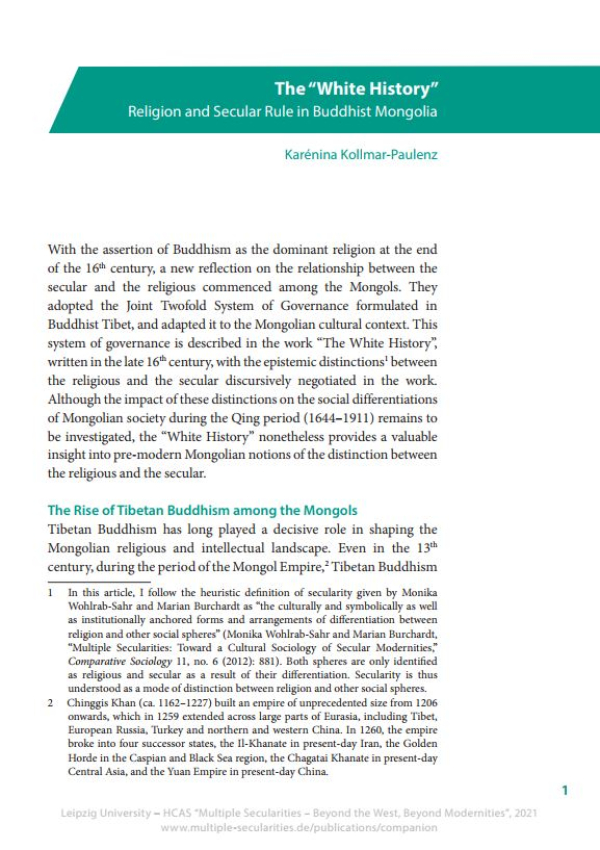 With the assertion of Buddhism as the dominant religion at the end of the 16th century, a new reflection on the relationship between the secular and the religious commenced among the Mongols. They adopted the Joint Twofold System of Governance formulated in Buddhist Tibet, and adapted it to the Mongolian cultural context. This system of governance is described in the work “The White History”, written in the late 16th century, with the epistemic distinctions between the religious and the secular discursively negotiated in the work. Although the impact of these distinctions on the social differentiations of Mongolian society during the Qing period (1644–1911) remains to be investigated, the “White History” nonetheless provides a valuable insight into pre-modern Mongolian notions of the distinction between the religious and the secular.
With the assertion of Buddhism as the dominant religion at the end of the 16th century, a new reflection on the relationship between the secular and the religious commenced among the Mongols. They adopted the Joint Twofold System of Governance formulated in Buddhist Tibet, and adapted it to the Mongolian cultural context. This system of governance is described in the work “The White History”, written in the late 16th century, with the epistemic distinctions between the religious and the secular discursively negotiated in the work. Although the impact of these distinctions on the social differentiations of Mongolian society during the Qing period (1644–1911) remains to be investigated, the “White History” nonetheless provides a valuable insight into pre-modern Mongolian notions of the distinction between the religious and the secular.
Read full textDownload pdf André Laliberté
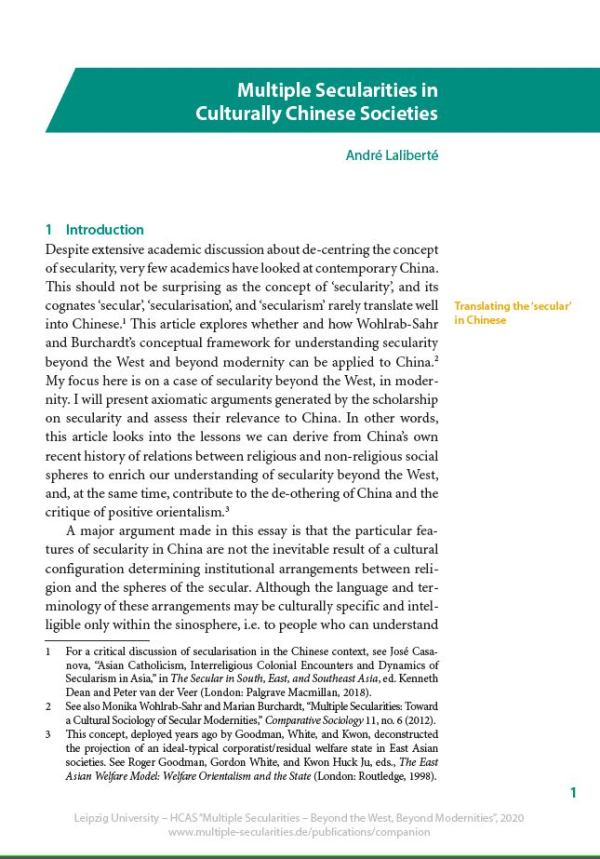 Despite extensive academic discussion about de-centring the concept of secularity, very few academics have looked at contemporary China. This should not be surprising as the concept of ‘secularity’, and its cognates ‘secular’, ‘secularisation’, and ‘secularism’ rarely translate well into Chinese. This article explores whether and how Wohlrab-Sahr and Burchardt’s conceptual framework for understanding secularity beyond the West and beyond modernity can be applied to China. This article looks into the lessons we can derive from China’s own recent history of relations between religious and non-religious social spheres to enrich our understanding of secularity beyond the West, and, at the same time, contribute to the de-othering of China and the critique of positive orientalism.
A major argument made in this essay is that the particular features of secularity in China are not the inevitable result of a cultural configuration determining institutional arrangements between religion and the spheres of the secular. Although the language and terminology of these arrangements may be culturally specific and intelligible only within the sinosphere, i.e. to people who can understand written Chinese, this does not pre-ordain the creation of a specific form of secular state such as the current mode of regulation of religion enforced by the Chinese Communist Party (CCP). The case of Taiwan, another important centre within the sinosphere where secularity differs from that seen in China, illustrates the vast repertoire of institutional arrangements possible in Chinese societies, and highlights the importance of agency in shaping institutions.
Despite extensive academic discussion about de-centring the concept of secularity, very few academics have looked at contemporary China. This should not be surprising as the concept of ‘secularity’, and its cognates ‘secular’, ‘secularisation’, and ‘secularism’ rarely translate well into Chinese. This article explores whether and how Wohlrab-Sahr and Burchardt’s conceptual framework for understanding secularity beyond the West and beyond modernity can be applied to China. This article looks into the lessons we can derive from China’s own recent history of relations between religious and non-religious social spheres to enrich our understanding of secularity beyond the West, and, at the same time, contribute to the de-othering of China and the critique of positive orientalism.
A major argument made in this essay is that the particular features of secularity in China are not the inevitable result of a cultural configuration determining institutional arrangements between religion and the spheres of the secular. Although the language and terminology of these arrangements may be culturally specific and intelligible only within the sinosphere, i.e. to people who can understand written Chinese, this does not pre-ordain the creation of a specific form of secular state such as the current mode of regulation of religion enforced by the Chinese Communist Party (CCP). The case of Taiwan, another important centre within the sinosphere where secularity differs from that seen in China, illustrates the vast repertoire of institutional arrangements possible in Chinese societies, and highlights the importance of agency in shaping institutions.
Read full textDownload pdfDagmar Schwerk
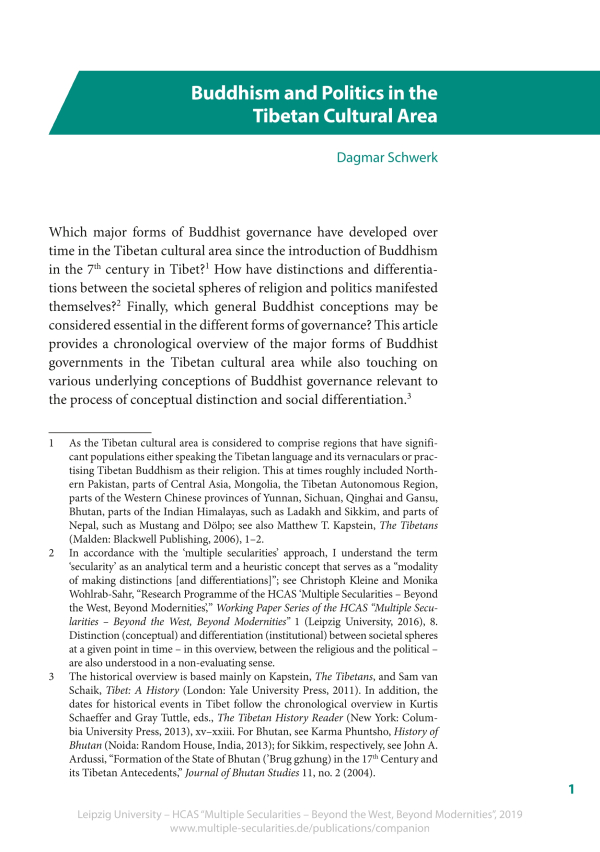 Which major forms of Buddhist governance have developed over time in the Tibetan cultural area since the introduction of Buddhism in the seventh century in Tibet? How have distinctions and differentiations between the societal spheres of religion and politics manifested themselves? Finally, which general Buddhist conceptions may be considered essential in the different forms of governance?
This article provides a chronological overview of the major forms of Buddhist governments in the Tibetan cultural area while also touching on various underlying conceptions of Buddhist governance relevant to the process of conceptual distinction and social differentiation.
Which major forms of Buddhist governance have developed over time in the Tibetan cultural area since the introduction of Buddhism in the seventh century in Tibet? How have distinctions and differentiations between the societal spheres of religion and politics manifested themselves? Finally, which general Buddhist conceptions may be considered essential in the different forms of governance?
This article provides a chronological overview of the major forms of Buddhist governments in the Tibetan cultural area while also touching on various underlying conceptions of Buddhist governance relevant to the process of conceptual distinction and social differentiation.
Read full textDownload pdfSushmita Nath
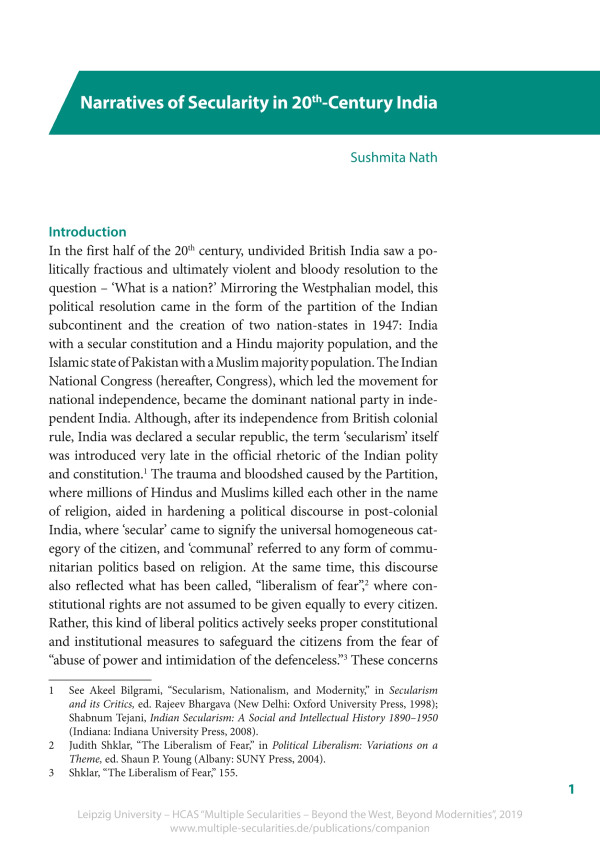 This article gives an overview of the various narratives of "secularity" in modern India, with a particular focus on the 20th century.
It traces how 'secularity' in India developed in response to the country's religious pluralism, from British colonial rule to independence movement and the recent present.
This article gives an overview of the various narratives of "secularity" in modern India, with a particular focus on the 20th century.
It traces how 'secularity' in India developed in response to the country's religious pluralism, from British colonial rule to independence movement and the recent present.
Read full textDownload pdfMohammad Magout
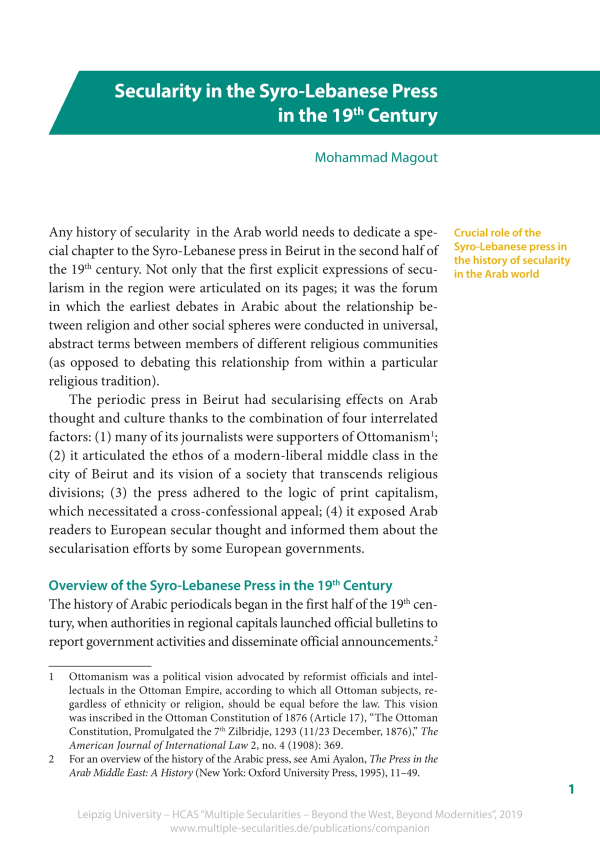 Any history of secularity in the Arab world needs to dedicate a special chapter to the Syro-Lebanese press in Beirut in the second half of the 19th century. Not only that the first explicit expressions of secularism in the region were articulated on its pages; it was the forum in which the earliest debates in Arabic about the relationship between religion and other social spheres were conducted in universal, abstract terms between members of different religious communities (as opposed to debating this relationship from within a particular religious tradition).
Any history of secularity in the Arab world needs to dedicate a special chapter to the Syro-Lebanese press in Beirut in the second half of the 19th century. Not only that the first explicit expressions of secularism in the region were articulated on its pages; it was the forum in which the earliest debates in Arabic about the relationship between religion and other social spheres were conducted in universal, abstract terms between members of different religious communities (as opposed to debating this relationship from within a particular religious tradition).
Read full textDownload pdfNeguin Yavari
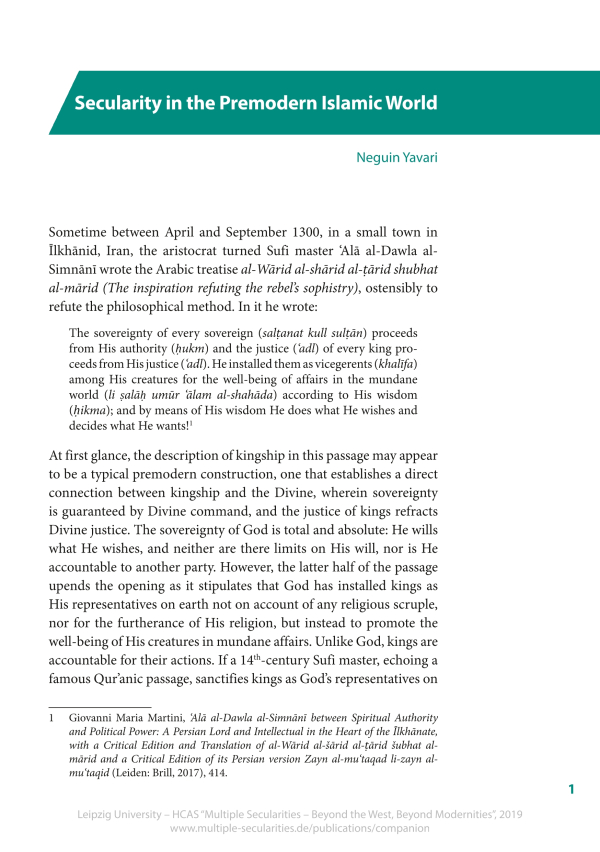 Sometime between April and September 1300, in a small town in
Īlkhānid, Iran, the aristocrat turned Sufi master ‘Alā al-Dawla alSimnānī wrote the Arabic treatise al-Wārid al-shārid al-ṭārid shubhat al-mārid (The inspiration refuting the rebel’s sophistry), ostensibly to refute the philosophical method.
Sometime between April and September 1300, in a small town in
Īlkhānid, Iran, the aristocrat turned Sufi master ‘Alā al-Dawla alSimnānī wrote the Arabic treatise al-Wārid al-shārid al-ṭārid shubhat al-mārid (The inspiration refuting the rebel’s sophistry), ostensibly to refute the philosophical method.
Read full textDownload pdfBernadett Bigalke
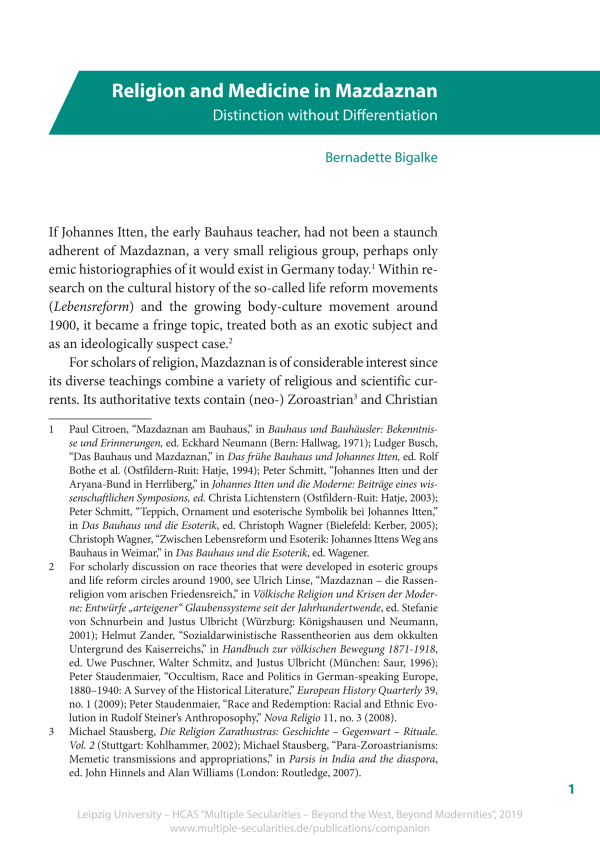 If Johannes Itten, the early Bauhaus teacher, had not been a staunch adherent of Mazdaznan, a very small religious group, perhaps only emic historiographies of it would exist in Germany today.
Within research on the cultural history of the so-called life reform movements (Lebensreform) and the growing body-culture movement around 1900, it became a fringe topic, treated both as an exotic subject and as an ideologically suspect case.
If Johannes Itten, the early Bauhaus teacher, had not been a staunch adherent of Mazdaznan, a very small religious group, perhaps only emic historiographies of it would exist in Germany today.
Within research on the cultural history of the so-called life reform movements (Lebensreform) and the growing body-culture movement around 1900, it became a fringe topic, treated both as an exotic subject and as an ideologically suspect case.
Read full textDownload pdfFlorian Zemmin
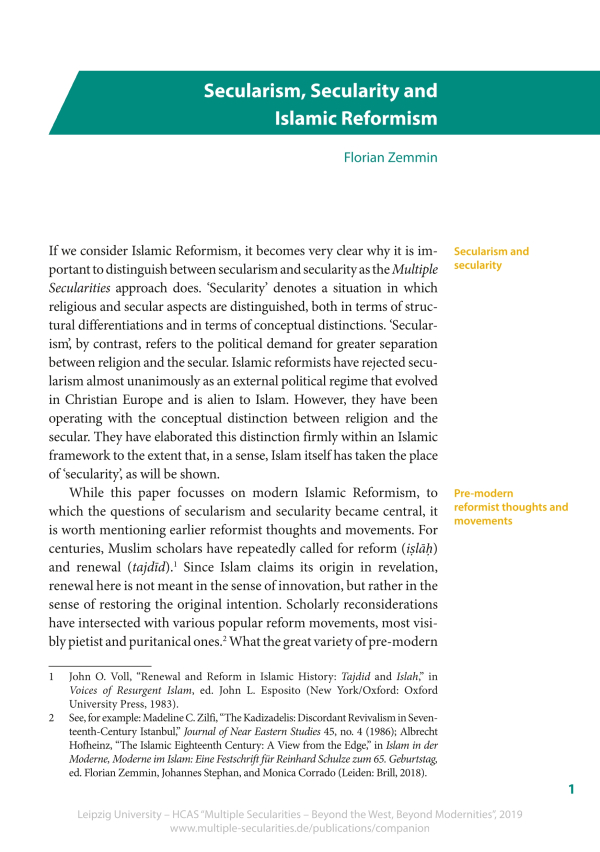 If we consider Islamic Reformism, it becomes very clear why it is important to distinguish between secularism and secularity as the Multiple Secularities approach does. ‘Secularity’ denotes a situation in which religious and secular aspects are distinguished, both in terms of structural differentiations and in terms of conceptual distinctions. ‘Secularism’, by contrast, refers to the political demand for greater separation between religion and the secular. Islamic reformists have rejected secularism almost unanimously as an external political regime that evolved in Christian Europe and is alien to Islam. However, they have been operating with the conceptual distinction between religion and the secular. They have elaborated this distinction firmly within an Islamic framework to the extent that, in a sense, Islam itself has taken the place of ‘secularity’, as will be shown.
If we consider Islamic Reformism, it becomes very clear why it is important to distinguish between secularism and secularity as the Multiple Secularities approach does. ‘Secularity’ denotes a situation in which religious and secular aspects are distinguished, both in terms of structural differentiations and in terms of conceptual distinctions. ‘Secularism’, by contrast, refers to the political demand for greater separation between religion and the secular. Islamic reformists have rejected secularism almost unanimously as an external political regime that evolved in Christian Europe and is alien to Islam. However, they have been operating with the conceptual distinction between religion and the secular. They have elaborated this distinction firmly within an Islamic framework to the extent that, in a sense, Islam itself has taken the place of ‘secularity’, as will be shown.
Read full textDownload pdfSilke Gülker
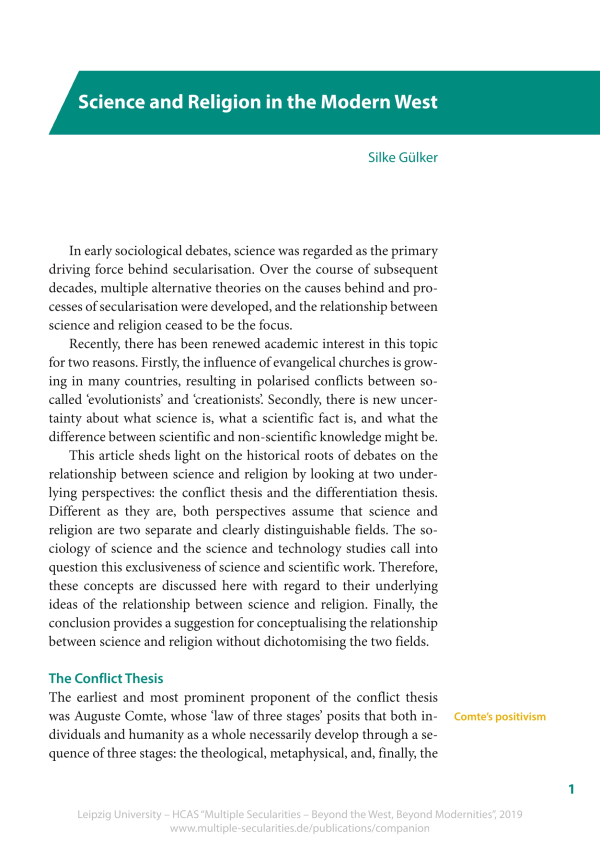 This article sheds light on the historical roots of debates on the relationship between science and religion by looking at two underlying perspectives: the conflict thesis and the differentiation thesis. Different as they are, both perspectives assume that science and religion are two separate and clearly distinguishable fields. The sociology of science and the science and technology studies call into question this exclusiveness of science and scientific work. Therefore, these concepts are discussed here with regard to their underlying ideas of the relationship between science and religion. Finally, the conclusion provides a suggestion for conceptualising the relationship between science and religion without dichotomising the two fields.
This article sheds light on the historical roots of debates on the relationship between science and religion by looking at two underlying perspectives: the conflict thesis and the differentiation thesis. Different as they are, both perspectives assume that science and religion are two separate and clearly distinguishable fields. The sociology of science and the science and technology studies call into question this exclusiveness of science and scientific work. Therefore, these concepts are discussed here with regard to their underlying ideas of the relationship between science and religion. Finally, the conclusion provides a suggestion for conceptualising the relationship between science and religion without dichotomising the two fields.
Read full textDownload pdfMuchamad Ali Safa'at
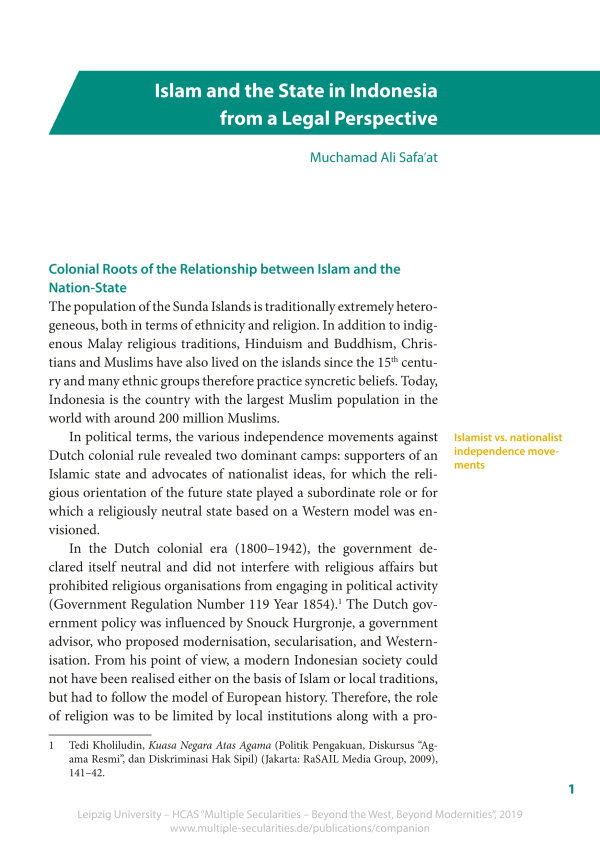 The relationship between Islam and the state has altered with regime changes in Indonesia. During the Old Order period, especially during the period of guided democracy, there was a separation between state and religion and state authorities even opposed Islamists. During the New Order period, religion was confined to the private realm and efforts were made to eliminate political religious movements and remove religious values and symbols from political life. During the Reformation Era, all groups have had the same space to grow and develop. But religious parties, including Islamic ones, have not gained a significant number of votes. This shows that there has been a major shift in the sociopolitical configuration of Indonesian society.
The relationship between Islam and the state has altered with regime changes in Indonesia. During the Old Order period, especially during the period of guided democracy, there was a separation between state and religion and state authorities even opposed Islamists. During the New Order period, religion was confined to the private realm and efforts were made to eliminate political religious movements and remove religious values and symbols from political life. During the Reformation Era, all groups have had the same space to grow and develop. But religious parties, including Islamic ones, have not gained a significant number of votes. This shows that there has been a major shift in the sociopolitical configuration of Indonesian society.
Read full textDownload pdfSaïd Amir Arjomand
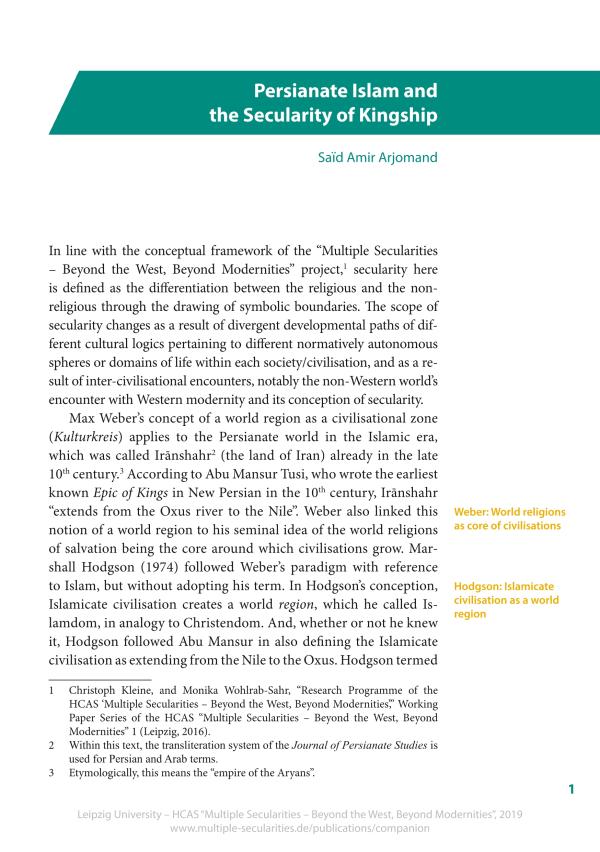 Starting from the 9th century, this entry illuminates the specific role that the New Persian played in establishing a specific Persianate culture and in the spread of Sufism as well as the idea of Persianate kingship. On the one hand, this conception of kingship clearly distinguished between religious/spiritual and political/worldly domains, but on the other hand saw kingship itself and prophecy as ordained by God.
Starting from the 9th century, this entry illuminates the specific role that the New Persian played in establishing a specific Persianate culture and in the spread of Sufism as well as the idea of Persianate kingship. On the one hand, this conception of kingship clearly distinguished between religious/spiritual and political/worldly domains, but on the other hand saw kingship itself and prophecy as ordained by God.
Read full textDownload pdfSaïd Amir Arjomand
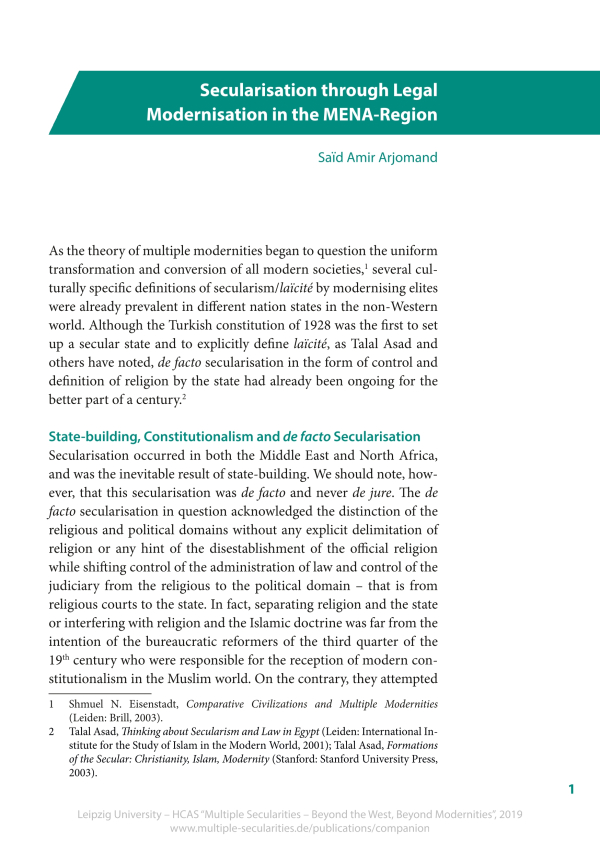 As the theory of multiple modernities began to question the uniform transformation and conversion of all modern societies, several culturally specific definitions of secularism/laïcité by modernising elites were already prevalent in different nation states in the non-Western world. Although the Turkish constitution of 1928 was the first to set up a secular state and to explicitly define laïcité, as Talal Asad and others have noted, de facto secularisation in the form of control and definition of religion by the state had already been ongoing for the better part of a century.
As the theory of multiple modernities began to question the uniform transformation and conversion of all modern societies, several culturally specific definitions of secularism/laïcité by modernising elites were already prevalent in different nation states in the non-Western world. Although the Turkish constitution of 1928 was the first to set up a secular state and to explicitly define laïcité, as Talal Asad and others have noted, de facto secularisation in the form of control and definition of religion by the state had already been ongoing for the better part of a century.
Read full textDownload pdfAdrian Hermann
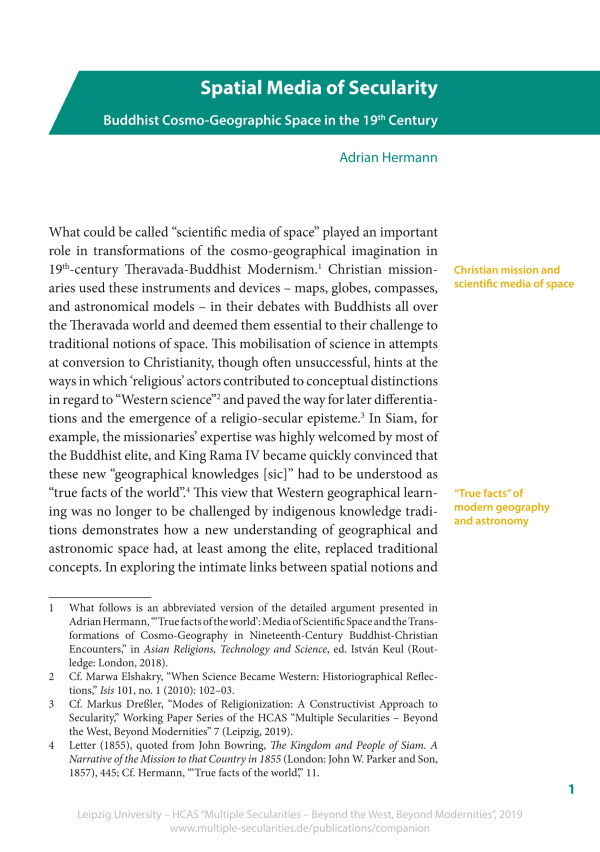 What could be called “scientific media of space” played an important role in transformations of the cosmo-geographical imagination in 19th-century Theravada-Buddhist Modernism. Christian missionaries used these instruments and devices – maps, globes, compasses, and astronomical models – in their debates with Buddhists all over the Theravada world and deemed them essential to their challenge to traditional notions of space. This mobilisation of science in attempts at conversion to Christianity, though often unsuccessful, hints at the ways in which ‘religious’ actors contributed to conceptual distinctions in regard to “Western science” and paved the way for later differentiations and the emergence of a religio-secular episteme.
What could be called “scientific media of space” played an important role in transformations of the cosmo-geographical imagination in 19th-century Theravada-Buddhist Modernism. Christian missionaries used these instruments and devices – maps, globes, compasses, and astronomical models – in their debates with Buddhists all over the Theravada world and deemed them essential to their challenge to traditional notions of space. This mobilisation of science in attempts at conversion to Christianity, though often unsuccessful, hints at the ways in which ‘religious’ actors contributed to conceptual distinctions in regard to “Western science” and paved the way for later differentiations and the emergence of a religio-secular episteme.
Read full textDownload pdfRuth Streicher, Adrian Hermann
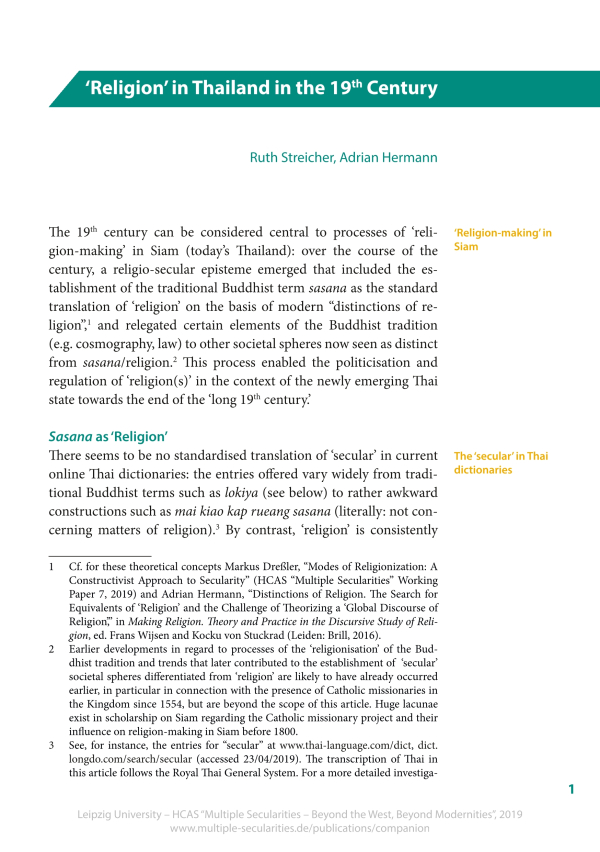 The 19th century can be considered central to processes of ‘religion-making’ in Siam (today’s Thailand): over the course of the century, a religio-secular episteme emerged that included the establishment of the traditional Buddhist term sasana as the standard translation of ‘religion’ on the basis of modern “distinctions of religion”, and relegated certain elements of the Buddhist tradition to other societal spheres now seen as distinct from sasana/religion. This process enabled the politicisation and regulation of ‘religion(s)’ in the context of the newly emerging Thai state towards the end of the ‘long 19th century.’
The 19th century can be considered central to processes of ‘religion-making’ in Siam (today’s Thailand): over the course of the century, a religio-secular episteme emerged that included the establishment of the traditional Buddhist term sasana as the standard translation of ‘religion’ on the basis of modern “distinctions of religion”, and relegated certain elements of the Buddhist tradition to other societal spheres now seen as distinct from sasana/religion. This process enabled the politicisation and regulation of ‘religion(s)’ in the context of the newly emerging Thai state towards the end of the ‘long 19th century.’
Read full textDownload pdfMarkus Dreßler
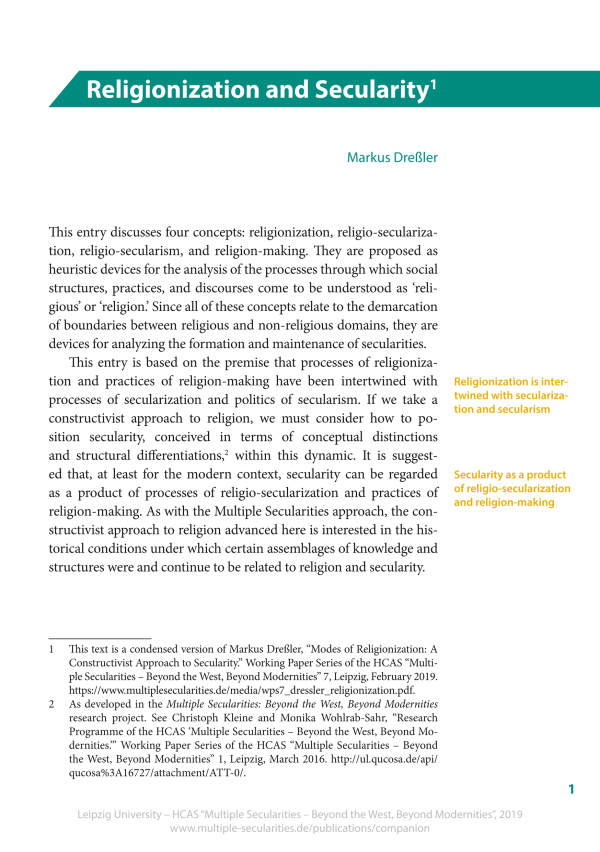 This entry discusses four concepts: religionization, religio-secularization, religio-secularism, and religion-making. They are proposed as heuristic devices for the analysis of the processes through which social structures, practices, and discourses come to be understood as ‘religious’ or ‘religion.’ Since all of these concepts relate to the demarcation of boundaries between religious and non-religious domains, they are devices for analyzing the formation and maintenance of secularities.
This entry discusses four concepts: religionization, religio-secularization, religio-secularism, and religion-making. They are proposed as heuristic devices for the analysis of the processes through which social structures, practices, and discourses come to be understood as ‘religious’ or ‘religion.’ Since all of these concepts relate to the demarcation of boundaries between religious and non-religious domains, they are devices for analyzing the formation and maintenance of secularities.
Read full textDownload pdfKatja Triplett
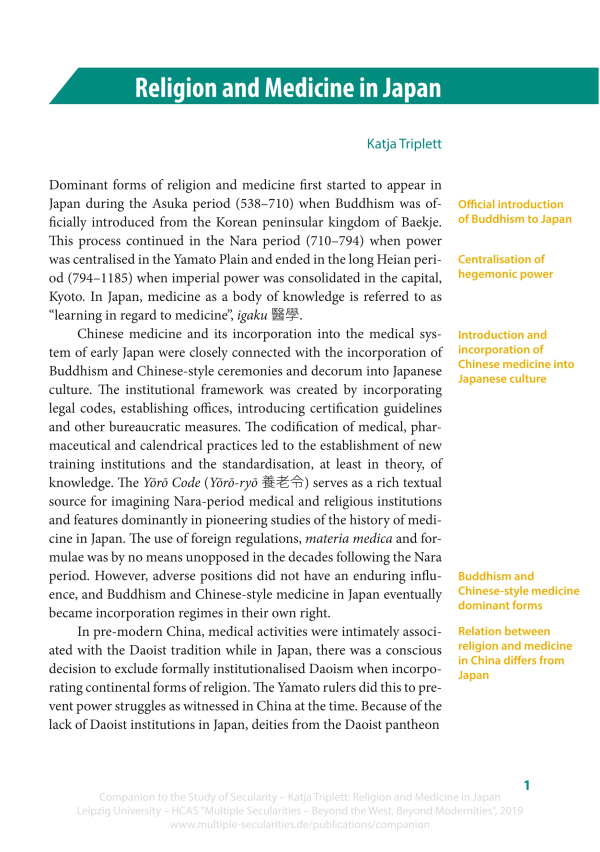 This article provides an historical overview of the development of the relationship between religion and medicine in Japan from the Asuka period (538-710), when Buddhism was officially introduced, to the 20th century.
It sheds light, among other things, on the impact of Chinese medicine as well as European influences on the medical system in Japan and traces the change in the relationship between two distinct but not necessarily separate spheres.
This article provides an historical overview of the development of the relationship between religion and medicine in Japan from the Asuka period (538-710), when Buddhism was officially introduced, to the 20th century.
It sheds light, among other things, on the impact of Chinese medicine as well as European influences on the medical system in Japan and traces the change in the relationship between two distinct but not necessarily separate spheres.
Read full textDownload pdfChristoph Kleine
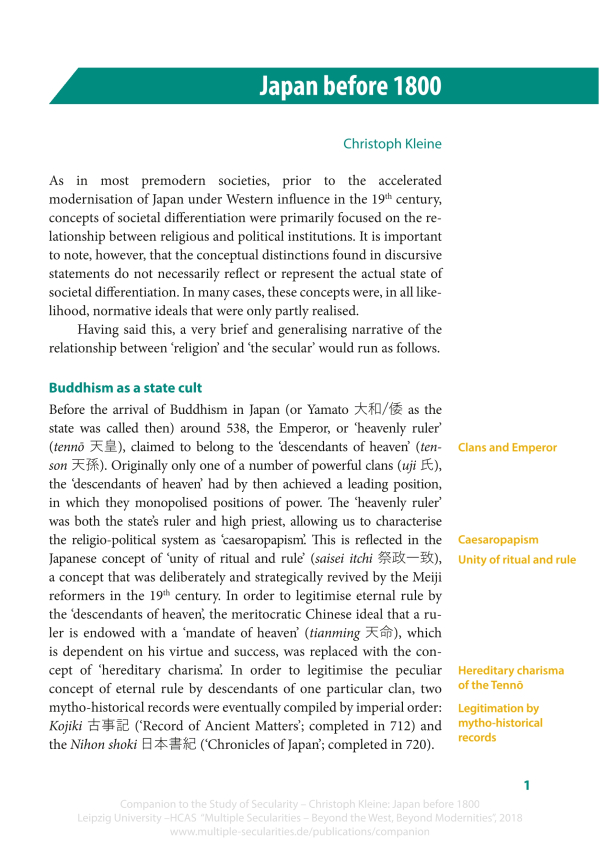 As in most premodern societies, prior to the accelerated modernisation of Japan under Western influence in the 19th century, concepts of societal differentiation were primarily focused on the relationship between religious and political institutions. It is important to note, however, that the conceptual distinctions found in discursive statements do not necessarily reflect or represent the actual state of societal differentiation. In many cases, these concepts were, in all likelihood, normative ideals that were only partly realised.
Having said this, a very brief and generalising narrative of the relationship between ‘religion’ and ‘the secular’ would run as follows.
As in most premodern societies, prior to the accelerated modernisation of Japan under Western influence in the 19th century, concepts of societal differentiation were primarily focused on the relationship between religious and political institutions. It is important to note, however, that the conceptual distinctions found in discursive statements do not necessarily reflect or represent the actual state of societal differentiation. In many cases, these concepts were, in all likelihood, normative ideals that were only partly realised.
Having said this, a very brief and generalising narrative of the relationship between ‘religion’ and ‘the secular’ would run as follows.
Read full textDownload pdf


 With the assertion of Buddhism as the dominant religion at the end of the 16th century, a new reflection on the relationship between the secular and the religious commenced among the Mongols. They adopted the Joint Twofold System of Governance formulated in Buddhist Tibet, and adapted it to the Mongolian cultural context. This system of governance is described in the work “The White History”, written in the late 16th century, with the epistemic distinctions between the religious and the secular discursively negotiated in the work. Although the impact of these distinctions on the social differentiations of Mongolian society during the Qing period (1644–1911) remains to be investigated, the “White History” nonetheless provides a valuable insight into pre-modern Mongolian notions of the distinction between the religious and the secular.
With the assertion of Buddhism as the dominant religion at the end of the 16th century, a new reflection on the relationship between the secular and the religious commenced among the Mongols. They adopted the Joint Twofold System of Governance formulated in Buddhist Tibet, and adapted it to the Mongolian cultural context. This system of governance is described in the work “The White History”, written in the late 16th century, with the epistemic distinctions between the religious and the secular discursively negotiated in the work. Although the impact of these distinctions on the social differentiations of Mongolian society during the Qing period (1644–1911) remains to be investigated, the “White History” nonetheless provides a valuable insight into pre-modern Mongolian notions of the distinction between the religious and the secular. Despite extensive academic discussion about de-centring the concept of secularity, very few academics have looked at contemporary China. This should not be surprising as the concept of ‘secularity’, and its cognates ‘secular’, ‘secularisation’, and ‘secularism’ rarely translate well into Chinese. This article explores whether and how Wohlrab-Sahr and Burchardt’s conceptual framework for understanding secularity beyond the West and beyond modernity can be applied to China. This article looks into the lessons we can derive from China’s own recent history of relations between religious and non-religious social spheres to enrich our understanding of secularity beyond the West, and, at the same time, contribute to the de-othering of China and the critique of positive orientalism.
A major argument made in this essay is that the particular features of secularity in China are not the inevitable result of a cultural configuration determining institutional arrangements between religion and the spheres of the secular. Although the language and terminology of these arrangements may be culturally specific and intelligible only within the sinosphere, i.e. to people who can understand written Chinese, this does not pre-ordain the creation of a specific form of secular state such as the current mode of regulation of religion enforced by the Chinese Communist Party (CCP). The case of Taiwan, another important centre within the sinosphere where secularity differs from that seen in China, illustrates the vast repertoire of institutional arrangements possible in Chinese societies, and highlights the importance of agency in shaping institutions.
Despite extensive academic discussion about de-centring the concept of secularity, very few academics have looked at contemporary China. This should not be surprising as the concept of ‘secularity’, and its cognates ‘secular’, ‘secularisation’, and ‘secularism’ rarely translate well into Chinese. This article explores whether and how Wohlrab-Sahr and Burchardt’s conceptual framework for understanding secularity beyond the West and beyond modernity can be applied to China. This article looks into the lessons we can derive from China’s own recent history of relations between religious and non-religious social spheres to enrich our understanding of secularity beyond the West, and, at the same time, contribute to the de-othering of China and the critique of positive orientalism.
A major argument made in this essay is that the particular features of secularity in China are not the inevitable result of a cultural configuration determining institutional arrangements between religion and the spheres of the secular. Although the language and terminology of these arrangements may be culturally specific and intelligible only within the sinosphere, i.e. to people who can understand written Chinese, this does not pre-ordain the creation of a specific form of secular state such as the current mode of regulation of religion enforced by the Chinese Communist Party (CCP). The case of Taiwan, another important centre within the sinosphere where secularity differs from that seen in China, illustrates the vast repertoire of institutional arrangements possible in Chinese societies, and highlights the importance of agency in shaping institutions. Which major forms of Buddhist governance have developed over time in the Tibetan cultural area since the introduction of Buddhism in the seventh century in Tibet? How have distinctions and differentiations between the societal spheres of religion and politics manifested themselves? Finally, which general Buddhist conceptions may be considered essential in the different forms of governance?
This article provides a chronological overview of the major forms of Buddhist governments in the Tibetan cultural area while also touching on various underlying conceptions of Buddhist governance relevant to the process of conceptual distinction and social differentiation.
Which major forms of Buddhist governance have developed over time in the Tibetan cultural area since the introduction of Buddhism in the seventh century in Tibet? How have distinctions and differentiations between the societal spheres of religion and politics manifested themselves? Finally, which general Buddhist conceptions may be considered essential in the different forms of governance?
This article provides a chronological overview of the major forms of Buddhist governments in the Tibetan cultural area while also touching on various underlying conceptions of Buddhist governance relevant to the process of conceptual distinction and social differentiation. This article gives an overview of the various narratives of "secularity" in modern India, with a particular focus on the 20th century.
It traces how 'secularity' in India developed in response to the country's religious pluralism, from British colonial rule to independence movement and the recent present.
This article gives an overview of the various narratives of "secularity" in modern India, with a particular focus on the 20th century.
It traces how 'secularity' in India developed in response to the country's religious pluralism, from British colonial rule to independence movement and the recent present. Any history of secularity in the Arab world needs to dedicate a special chapter to the Syro-Lebanese press in Beirut in the second half of the 19th century. Not only that the first explicit expressions of secularism in the region were articulated on its pages; it was the forum in which the earliest debates in Arabic about the relationship between religion and other social spheres were conducted in universal, abstract terms between members of different religious communities (as opposed to debating this relationship from within a particular religious tradition).
Any history of secularity in the Arab world needs to dedicate a special chapter to the Syro-Lebanese press in Beirut in the second half of the 19th century. Not only that the first explicit expressions of secularism in the region were articulated on its pages; it was the forum in which the earliest debates in Arabic about the relationship between religion and other social spheres were conducted in universal, abstract terms between members of different religious communities (as opposed to debating this relationship from within a particular religious tradition). Sometime between April and September 1300, in a small town in
Īlkhānid, Iran, the aristocrat turned Sufi master ‘Alā al-Dawla alSimnānī wrote the Arabic treatise al-Wārid al-shārid al-ṭārid shubhat al-mārid (The inspiration refuting the rebel’s sophistry), ostensibly to refute the philosophical method.
Sometime between April and September 1300, in a small town in
Īlkhānid, Iran, the aristocrat turned Sufi master ‘Alā al-Dawla alSimnānī wrote the Arabic treatise al-Wārid al-shārid al-ṭārid shubhat al-mārid (The inspiration refuting the rebel’s sophistry), ostensibly to refute the philosophical method.  If Johannes Itten, the early Bauhaus teacher, had not been a staunch adherent of Mazdaznan, a very small religious group, perhaps only emic historiographies of it would exist in Germany today.
Within research on the cultural history of the so-called life reform movements (Lebensreform) and the growing body-culture movement around 1900, it became a fringe topic, treated both as an exotic subject and as an ideologically suspect case.
If Johannes Itten, the early Bauhaus teacher, had not been a staunch adherent of Mazdaznan, a very small religious group, perhaps only emic historiographies of it would exist in Germany today.
Within research on the cultural history of the so-called life reform movements (Lebensreform) and the growing body-culture movement around 1900, it became a fringe topic, treated both as an exotic subject and as an ideologically suspect case. If we consider Islamic Reformism, it becomes very clear why it is important to distinguish between secularism and secularity as the Multiple Secularities approach does. ‘Secularity’ denotes a situation in which religious and secular aspects are distinguished, both in terms of structural differentiations and in terms of conceptual distinctions. ‘Secularism’, by contrast, refers to the political demand for greater separation between religion and the secular. Islamic reformists have rejected secularism almost unanimously as an external political regime that evolved in Christian Europe and is alien to Islam. However, they have been operating with the conceptual distinction between religion and the secular. They have elaborated this distinction firmly within an Islamic framework to the extent that, in a sense, Islam itself has taken the place of ‘secularity’, as will be shown.
If we consider Islamic Reformism, it becomes very clear why it is important to distinguish between secularism and secularity as the Multiple Secularities approach does. ‘Secularity’ denotes a situation in which religious and secular aspects are distinguished, both in terms of structural differentiations and in terms of conceptual distinctions. ‘Secularism’, by contrast, refers to the political demand for greater separation between religion and the secular. Islamic reformists have rejected secularism almost unanimously as an external political regime that evolved in Christian Europe and is alien to Islam. However, they have been operating with the conceptual distinction between religion and the secular. They have elaborated this distinction firmly within an Islamic framework to the extent that, in a sense, Islam itself has taken the place of ‘secularity’, as will be shown. This article sheds light on the historical roots of debates on the relationship between science and religion by looking at two underlying perspectives: the conflict thesis and the differentiation thesis. Different as they are, both perspectives assume that science and religion are two separate and clearly distinguishable fields. The sociology of science and the science and technology studies call into question this exclusiveness of science and scientific work. Therefore, these concepts are discussed here with regard to their underlying ideas of the relationship between science and religion. Finally, the conclusion provides a suggestion for conceptualising the relationship between science and religion without dichotomising the two fields.
This article sheds light on the historical roots of debates on the relationship between science and religion by looking at two underlying perspectives: the conflict thesis and the differentiation thesis. Different as they are, both perspectives assume that science and religion are two separate and clearly distinguishable fields. The sociology of science and the science and technology studies call into question this exclusiveness of science and scientific work. Therefore, these concepts are discussed here with regard to their underlying ideas of the relationship between science and religion. Finally, the conclusion provides a suggestion for conceptualising the relationship between science and religion without dichotomising the two fields. The relationship between Islam and the state has altered with regime changes in Indonesia. During the Old Order period, especially during the period of guided democracy, there was a separation between state and religion and state authorities even opposed Islamists. During the New Order period, religion was confined to the private realm and efforts were made to eliminate political religious movements and remove religious values and symbols from political life. During the Reformation Era, all groups have had the same space to grow and develop. But religious parties, including Islamic ones, have not gained a significant number of votes. This shows that there has been a major shift in the sociopolitical configuration of Indonesian society.
The relationship between Islam and the state has altered with regime changes in Indonesia. During the Old Order period, especially during the period of guided democracy, there was a separation between state and religion and state authorities even opposed Islamists. During the New Order period, religion was confined to the private realm and efforts were made to eliminate political religious movements and remove religious values and symbols from political life. During the Reformation Era, all groups have had the same space to grow and develop. But religious parties, including Islamic ones, have not gained a significant number of votes. This shows that there has been a major shift in the sociopolitical configuration of Indonesian society. Starting from the 9th century, this entry illuminates the specific role that the New Persian played in establishing a specific Persianate culture and in the spread of Sufism as well as the idea of Persianate kingship. On the one hand, this conception of kingship clearly distinguished between religious/spiritual and political/worldly domains, but on the other hand saw kingship itself and prophecy as ordained by God.
Starting from the 9th century, this entry illuminates the specific role that the New Persian played in establishing a specific Persianate culture and in the spread of Sufism as well as the idea of Persianate kingship. On the one hand, this conception of kingship clearly distinguished between religious/spiritual and political/worldly domains, but on the other hand saw kingship itself and prophecy as ordained by God. As the theory of multiple modernities began to question the uniform transformation and conversion of all modern societies, several culturally specific definitions of secularism/laïcité by modernising elites were already prevalent in different nation states in the non-Western world. Although the Turkish constitution of 1928 was the first to set up a secular state and to explicitly define laïcité, as Talal Asad and others have noted, de facto secularisation in the form of control and definition of religion by the state had already been ongoing for the better part of a century.
As the theory of multiple modernities began to question the uniform transformation and conversion of all modern societies, several culturally specific definitions of secularism/laïcité by modernising elites were already prevalent in different nation states in the non-Western world. Although the Turkish constitution of 1928 was the first to set up a secular state and to explicitly define laïcité, as Talal Asad and others have noted, de facto secularisation in the form of control and definition of religion by the state had already been ongoing for the better part of a century. What could be called “scientific media of space” played an important role in transformations of the cosmo-geographical imagination in 19th-century Theravada-Buddhist Modernism. Christian missionaries used these instruments and devices – maps, globes, compasses, and astronomical models – in their debates with Buddhists all over the Theravada world and deemed them essential to their challenge to traditional notions of space. This mobilisation of science in attempts at conversion to Christianity, though often unsuccessful, hints at the ways in which ‘religious’ actors contributed to conceptual distinctions in regard to “Western science” and paved the way for later differentiations and the emergence of a religio-secular episteme.
What could be called “scientific media of space” played an important role in transformations of the cosmo-geographical imagination in 19th-century Theravada-Buddhist Modernism. Christian missionaries used these instruments and devices – maps, globes, compasses, and astronomical models – in their debates with Buddhists all over the Theravada world and deemed them essential to their challenge to traditional notions of space. This mobilisation of science in attempts at conversion to Christianity, though often unsuccessful, hints at the ways in which ‘religious’ actors contributed to conceptual distinctions in regard to “Western science” and paved the way for later differentiations and the emergence of a religio-secular episteme. The 19th century can be considered central to processes of ‘religion-making’ in Siam (today’s Thailand): over the course of the century, a religio-secular episteme emerged that included the establishment of the traditional Buddhist term sasana as the standard translation of ‘religion’ on the basis of modern “distinctions of religion”, and relegated certain elements of the Buddhist tradition to other societal spheres now seen as distinct from sasana/religion. This process enabled the politicisation and regulation of ‘religion(s)’ in the context of the newly emerging Thai state towards the end of the ‘long 19th century.’
The 19th century can be considered central to processes of ‘religion-making’ in Siam (today’s Thailand): over the course of the century, a religio-secular episteme emerged that included the establishment of the traditional Buddhist term sasana as the standard translation of ‘religion’ on the basis of modern “distinctions of religion”, and relegated certain elements of the Buddhist tradition to other societal spheres now seen as distinct from sasana/religion. This process enabled the politicisation and regulation of ‘religion(s)’ in the context of the newly emerging Thai state towards the end of the ‘long 19th century.’ This entry discusses four concepts: religionization, religio-secularization, religio-secularism, and religion-making. They are proposed as heuristic devices for the analysis of the processes through which social structures, practices, and discourses come to be understood as ‘religious’ or ‘religion.’ Since all of these concepts relate to the demarcation of boundaries between religious and non-religious domains, they are devices for analyzing the formation and maintenance of secularities.
This entry discusses four concepts: religionization, religio-secularization, religio-secularism, and religion-making. They are proposed as heuristic devices for the analysis of the processes through which social structures, practices, and discourses come to be understood as ‘religious’ or ‘religion.’ Since all of these concepts relate to the demarcation of boundaries between religious and non-religious domains, they are devices for analyzing the formation and maintenance of secularities. This article provides an historical overview of the development of the relationship between religion and medicine in Japan from the Asuka period (538-710), when Buddhism was officially introduced, to the 20th century.
It sheds light, among other things, on the impact of Chinese medicine as well as European influences on the medical system in Japan and traces the change in the relationship between two distinct but not necessarily separate spheres.
This article provides an historical overview of the development of the relationship between religion and medicine in Japan from the Asuka period (538-710), when Buddhism was officially introduced, to the 20th century.
It sheds light, among other things, on the impact of Chinese medicine as well as European influences on the medical system in Japan and traces the change in the relationship between two distinct but not necessarily separate spheres. As in most premodern societies, prior to the accelerated modernisation of Japan under Western influence in the 19th century, concepts of societal differentiation were primarily focused on the relationship between religious and political institutions. It is important to note, however, that the conceptual distinctions found in discursive statements do not necessarily reflect or represent the actual state of societal differentiation. In many cases, these concepts were, in all likelihood, normative ideals that were only partly realised.
Having said this, a very brief and generalising narrative of the relationship between ‘religion’ and ‘the secular’ would run as follows.
As in most premodern societies, prior to the accelerated modernisation of Japan under Western influence in the 19th century, concepts of societal differentiation were primarily focused on the relationship between religious and political institutions. It is important to note, however, that the conceptual distinctions found in discursive statements do not necessarily reflect or represent the actual state of societal differentiation. In many cases, these concepts were, in all likelihood, normative ideals that were only partly realised.
Having said this, a very brief and generalising narrative of the relationship between ‘religion’ and ‘the secular’ would run as follows. 